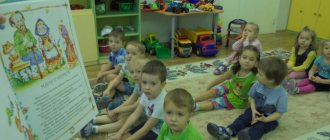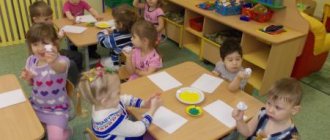Summary of theatrical play in the younger group
Target:
teach children to create images of living beings using plastic expressive means, to orient children in the group space, and to build role-playing dialogue.
Tasks:
Correctional educational tasks:
learn to remember and say the words of a fairy tale in accordance with the chosen role
Correction and development tasks:
develop the ability to coordinate actions with other children - the heroes of a fairy tale, develop auditory attention, imagination, and interest in performing arts. Develop coordination of movements, plastic expressiveness, imagination, encourage children to actively participate in theatrical play.
Correctional and educational tasks:
To cultivate friendly relationships, goodwill, and a desire to help in younger preschoolers. Help create a joyful emotional mood in children.
Vocabulary work:
Activating the dictionary:
teremok.
Dictionary enrichment:
prowls, lurks, cheat
Integration of educational areas:
cognitive development, socio-communicative development.
Preliminary work:
creating conditions in the group for joint theatrical activities between the teacher and children, showing children various types of theater and Russian folk tales, their dramatization, viewing illustrations, discussing the content of fairy tales, outdoor games, classes in theatrical activities, watching and listening to Russian folk tales on video and audio recordings .
Equipment and material:
demo material:
a wonderful bag, hats - masks of the heroes of the fairy tale "Teremok", a tape recorder, phonograms, heroes of the fairy tale "Teremok" on cubes, large building material for the teremok.
Handout:
masks with heroes of the fairy tale “Teremok”.
Progress of the game:
Children stand in a semicircle in front of the teacher.
Educator:
Guys, let's smile at each other and show that we are in a good mood. Do you want to go on a trip? Now let's go with you to the forest. Look, there's a path, let's follow it.
The children walked along the path, They found a bag along the way, But the bag is not an ordinary one, It’s magical - like that!
Guys, I wonder what's in the bag? Let's get a look! These are riddles, listen and guess them.
From the bag, after each guess, the teacher takes out a small cube with an image of an animal (theater on cubes). And puts it on the table.
PUZZLES:
A small, white one, jumping and jumping through the forest, poke-poke across the snow. ( Hare )
Jumps on the ground, swims on the water. ( Frog)
Who walks around angry and hungry in the cold winter. ( Wolf )
The red-haired cheat, cunning and dexterous, got into the barn and counted the chickens. ( Fox)
In winter he sleeps, in summer he stirs up the hives. ( Bear)
A little gray ball is fumbling under the floor. (Mouse)
- Guys, who guessed what fairy tale these animals are from? That's right, Teremok! Do you want to turn into the heroes of a fairy tale? Wear hats and masks. I will read a poem about the heroes of a fairy tale, and you guys take turns and portray the animal in question.
Children put on hats and masks (bear, frog, mouse, fox, wolf, hare), sit on chairs, the teacher tells a short poetic description of the characters, and the child imitates the movements.
Fox, fox, fox! Very cunning eyes, Fur coat - you can’t take your eyes off. “I love to eat chicken!”
A clumsy, clubfooted bear walks through the forest. If they ask what he likes, he will say: “I would like to eat honey!”
The bunny went out for a walk, he began to jump and play. Suddenly there was a crack and a click, the bunny pressed his ears and jumped.
The frog, with his eyes bulging, sits and does not speak Russian. She loves to live alone in the swamp, she catches mosquitoes.
A gray toothy wolf prowls the field, looking for calves and lambs.
A little gray mouse is hiding under the floor, afraid of cats.
- Well done boys. Now let's play a fairy tale.
After this, a dramatization of the fairy tale “Teremok” is carried out. To the accompaniment of a Russian folk melody, the teacher builds a tower on the table from large cubes.
There is a teremok in the field - a teremok. He is not short, not high, not tall. A mouse runs across the field, stops at the gate and says...
The text of the tale ends with the words:
They lived together, didn’t bother, Stoked the stove in the house... Bear destroyed the house, Almost crushed his friends.
At the end of the fairy tale, a problematic question is posed to the children: “What should we do? What should we do? It is necessary to make children want to build a new tower. Children are building a new tower to the tune of a Russian folk melody.
Get up guys in a round dance, let's dance.
Then all the children sit in a circle and the fairy tale ends with the words:
There is a mansion in the field, a mansion, It is very, very tall, oh, tall. You can’t live here without fun, Friends live in the mansion!
- Well done, everyone coped with their role. Take off your hats and masks, and now you are guys again.
– The guys were artists and the guys showed a fairy tale...
The artists were very good, let's clap for each other kids!
Abstract
theatrical play in the younger group
prepared by the teacher
Ivanova Svetlana Galimzyanovna
How to conduct a theatrical game in the first junior group of kindergarten
The material for this kind of creative activity in the first junior group is fairy tales, poems, and nursery rhymes considered in the program. Moreover, some of them form the basis for several games. For example, the work “Toys” by Agnia Barto can be used both for dramatization (imitation) and for a director’s game (board game).
Table: card index of theatrical games in the first junior group (fragment)
| Author | Shandina N.V., teacher at MBDOU “Kindergarten No. 16”, Bogorodsk, Nizhny Novgorod region. | |||
| Name of the game | Material | Type of game | Tasks | At what lesson (regime moment) is it used? |
| "In our yard" | Fairy tale "Turnip" | Director's (on flannelgraph). |
| Speech development while walking |
| “The ducklings came out onto the meadow” | A. Barto “Toys” |
|
| Regime moments |
| "Kolobok" | "Kolobok" |
|
| Speech development while walking |
| "Cucumber, cucumber" | Nursery rhyme "Cucumber, cucumber" | Dramatization (plot-role-playing). |
| On a walk |
| "Our ducks in the morning..." | Nursery rhyme “Our ducks in the morning...” | Dramatization (imitation). |
| Regular moments (morning gathering) |
| Quote from: https://nsportal.ru/detskiy-sad/raznoe/2016/12/04/kartoteka-teatralizovannyh-igr-v-pervoy-mladshey-gruppe | ||||
Time plan for theatrical play
Any element of the educational process in kindergarten is carefully timed. In early preschool age, children are just learning the ability to concentrate on one or another type of activity, so the duration of the game included in the lesson does not exceed 7 minutes. But if the organized theatrical activity is a series of games, that is, a whole lesson, then its duration is 12–15 minutes.
The theatrical play has a four-part structure:
- Introducing the game (updating basic knowledge) - 2–3 minutes. At this stage, the teacher, using motivational techniques, leads the students to the topic of the game and announces its name.
- Explanation of the game conditions and demonstration of the game actions of each participant - 2–4 minutes.
- The game itself takes 6–10 minutes. At this stage, the teacher participates, helps, and guides the children. You cannot go into the position of an observer. If it is intended to introduce additional game actions, then this is carried out at the third stage.
- The final stage is 1–2 minutes. The teacher praises the kids, asks if they liked the game, and always evaluates the work of the entire group (“You did a great job!”).
This is interesting. In some games, the explanation and game phases are combined.
If children pick up dolls for the first time, then this must be taken into account when drawing up notes and allocate 2-3 minutes more to the game
Table: example of a summary of the theatrical game “Turnip” in the first junior group (fragment)
| Author | Lukashuk I.V., teacher of MDOU D/s No. 48 “Ladushki”, Voskresensk, Moscow region. |
| Target | To form children’s interest in theatrical and play activities, to enrich the passive and intensify the conversational speech of pupils. |
| Introductory stage | V.: Children! Tell me, what time of year is it now? (Autumn). And in the fall a big harvest ripens! Today we will take a look at the garden. Shall we go to the garden? Dance “Ogorodnaya - round dance” to the tune “Like ours at the gate...”.
|
| Explanation of conditions, demonstration and play | V.: And a turnip grew in our garden. (Places a large turnip in the center of the group). Who will pull the turnip? (Grandfather). And grandpa is old, he walks slowly, like this! (Children imitate the image of their grandfather). He pulls and pulls, but he can’t pull it out! Who did grandfather call? (Grandma). Meanwhile, grandma was baking pancakes. Song "Ladushki". V.: Grandma, go pull the turnip! They pull - they pull, (Children “pull” the turnip) They can’t pull it out!...>, <,... V.: The cat sat on the fence, it’s scaring the birds. Nursery rhyme:
|
| The final stage | The teacher takes the turnip in his hands.
The teacher thanks the children for their work. |
| Quote from: https://blog.dohcolonoc.ru/entry/zanyatiya/konspekt-teatralizovannoj-igry-repka-v-1-mladshej-gruppe.html | |
Video: theatrical play based on the fairy tale “Teremok”
Theatrical performance in the first junior group is not only a way to reveal the creative abilities of children, but also a suitable platform for the implementation of educational tasks outlined in the educational program for younger preschoolers. Despite the fact that children do not yet fully speak, the variety of games allows children to try themselves in both directing and dramatization. At the same time, the methodological feasibility and result of working on the game depend on the skill of the teacher who selects and organizes this type of activity for his little pupils.






